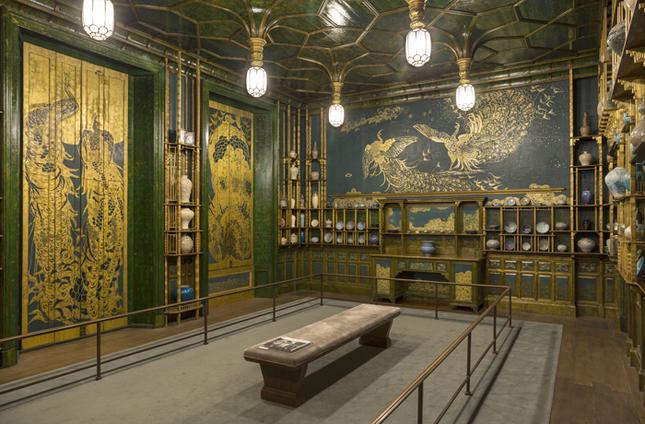Freer Gallery to Close for Renovations, Jan. 4
By • January 11, 2016 0 1057

The Freer Gallery of Art, the oldest of the Smithsonian Institution’s art museums, will be closed for renovations from Jan. 4 through the spring or summer of 2017. The Sackler Gallery, to which it is linked underground — forming a bicameral museum of Asian art — will remain open.
Along with its extraordinary Asian holdings, the Freer is the home of a major collection of works by American expatriate artist James Abbott McNeill Whistler, of “Whistler’s Mother” fame (that painting, formally known as “Arrangement in Grey and Black No. 1,” is owned by Paris’s Musée d’Orsay), including his stunning Peacock Room.
On the third Thursday of the month at noon, the Peacock Room shutters are opened, allowing its flamboyantly colored and decorated walls and ceramics-packed shelves to be bathed in natural light. The last opportunity to experience this for a year and a half is this Thursday, Dec. 17.
Jan. 2-3 is “Say Goodbye to the Freer” weekend, with many family-friendly activities from 10 a.m. to 5:30 p.m.
Julian Raby, director of the Freer-Sackler since 2002, was the speaker at Georgetown Media Group’s Nov. 5 Cultural Leadership Breakfast at the George Town Club. In his remarks, Raby brought to life the beginnings of the Freer Gallery of Art, dedicated in 1923 and spawned by the ideals of its founder, Charles Lang Freer, a full-cloth American self-made man.
“There was no silver spoon in the mouth of Charles Lang Freer,” he said, noting his beginnings as a maker and developer of railroad cars, which made him nearly a billionaire and allowed him to retire at age 47. He also had the good fortune, spurred by an interest in art collecting, to meet and be associated with Whistler, from whom he at first bought just a modest etching.
“The relationship was an extraordinary match,” Raby said. “Whistler was choleric, quixotic, and Freer was an extremely thoughtful man. It was a match that would lead to the acquisition of 1,300 works which formed the foundation of the collection and started a passion in Freer, and even obsession, with Asian art and culture, prints and screens and with China.”
“Imagine,” Raby said, “a relationship somewhat like what Velázquez might have had with the hidalgos” (a phrase you won’t hear every day). The complex history of the Peacock Room, created for British shipping magnate Frederick Richards Leyland and setting off a bitter feud between patron and artist, is currently the subject of a special Sackler Gallery exhibition, “Peacock Room REMIX.” The show’s centerpiece is “Filthy Lucre,” a recreation of the room in ruins by painter Darren Waterston.
Regarding the original Peacock Room, says Raby, “when we open the windows and let the light in, it’s still spectacular.”

